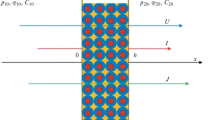Abstract
For a tetrabutylammonium-selective electrode with a ion-exchange membrane, in the real-work scenario corresponding to the determination of selectivity coefficients by the IUPAC-recommended method of separate solutions, it is shown that of the results of calculations obtained within the framework of the dynamic diffusion model based on the use of the finite-difference technique substantially depend on of the chosen boundary conditions and the values of arbitrarily set simulation parameters. The key parameter that determines the quality of simulation results is the thickness of the elementary layer in the membrane phase, especially for low diffusion coefficients. It is found that the use of thin elementary layers in membranes and thick elementary layers in the aqueous phase makes it possible to combine the high quality with the high calculation rate. In simulating the long-term experiments, account should be taken of the accumulation of the potential-determining ion in the aqueous solution volume as a result of its displacement by a foreign ion from the membrane. A good correspondence between calculation data and experimental results is demonstrated.
Similar content being viewed by others
References
Sokalski, T., Ceresa, A., Zwickl, T., and Pretsch, E., Large improvement of the lower detection limit of ionselective polymer membrane electrodes, J. Amer. Chem. Soc., 1997, vol. 119, p. 11347.
Sokalski, T., Zwickl, T., Bakker, E., and Pretch, E., Lowering the detection limit of solvent polymeric ionselective electrodes. 1. Modeling the influence of steady-state ion fluxes, Anal. Chem., 1999, vol. 71, p. 1204.
Bakker, E., Generalized selectivity description for polymeric ion-selective electrodes based on the phase boundary potential model, J. Electroanal. Chem., 2010, vol. 639, p. 1.
Fibbioli, M., Morf, W.E., Badertscher, M., de Rooij, N.F., and Pretsch, E., Potential drifts of solid-contacted ionselective electrodes due to zero-current ion fluxes through the sensor membrane, Electroanalysis, 2000, vol. 12, no. 16, p. 1286.
Morf, W.E., Badertscher, M., Zwickl, T., Reichmuth, P., de Rooij, N.F., and Pretch, E., Calculated effects of membrane transport on the long-term response behavior of polymeric membrane ion-selective electrodes, J. Phys. Chem. B, 2000, vol. 104, p. 8201.
Zwickl, T., Sokalski, T., and Pretsch, E., Steady-state model calculations predicting the influence of key parameters on the lower detection limit and ruggedness of solvent polymeric membrane ion-selective electrodes, Electroanalysis, 1999, vol. 11, no. 10–11, p. 673.
Morf, W.E., Badertscher, M., Zwickl, T., de Rooij, N.F., and Pretsch, E., Effects of ion transport on the potential response of ionophore-based membrane electrodes: a theoretical approach, J. Phys. Chem. B., 1999, vol. 103, p. 11346.
Radu, A., Meir, A.J., and Bakker, E., Dynamic diffusion model for tracing the real-time potential response of polymeric membrane ion-selective electrodes, Anal. Chem., 2004, vol. 76, p. 6402.
Sokalski, T. and Lewenstam, A., Application of Nernst-Planck and Poisson equations for interpretation of liquid-junction and membrane potentials in realtime and space domains, Electrochem. Commun., 2001, vol. 3, no. 3, p. 107.
Morf, W.E., Pretsch, E., and de Rooij, N.F., Theory and computer simulation of the time-dependent selectivity behavior of polymeric membrane ion-selective electrodes, J. Electroanal. Chem, 2008, vol. 614, p. 15.
Morf, W.E., Pretsch, E., and de Rooij, N.F., Memory effects of ion-selective electrodes: theory and computer simulation of the time-dependent potential response to multiple sample changes, J. Electroanal. Chem., 2009, vol. 633, p. 137.
Morf, W.E., The Principles of Ion-Selective Electrodes and of Membrane Transport, New York: Elsevier, 1981, translated into Russian.
Egorov, V.V., Zdrachek, E.A., and Nazarov, V.A., Improved separate solution method for determination of low selectivity coefficients, Anal. Chem., 2014, vol. 86, p. 3693.
Zdrachek, E.A., Nazarov, V.A., and Egorov, V.V., Generalized diffusion parameter: main factors of influence and application for estimation of selectivity coefficients for highly selective electrodes, Electroanalysis, 2015, vol. 27, p. 693.
Zdrachek, E.A., Nazarov, V.A., and Egorov, V.V., The method of estimation of diffusion coefficients of ions in membranes of ion-selective electrodes based on potentiometric data, Vestn. BGU: Ser. 2, 2014, no. 1, p. 10.
Morf, W.E., Pretsch, E., and Rooij, N.F., Computer simulation of ion-selective membrane electrodes and related systems by finite-difference procedures, J. Electroanal. Chem., 2007, vol. 602, p. 43.
Bakker, E., Evaluation of Egorov`s improved separate solution method for determination of low selectivity coefficients by numerical simulation, Anal. Chem., 2014, vol. 86, p. 8021.
Egorov, V.V. and Bolotin, A.A., Effect of membrane composition on the selectivity of electrodes selective for alkylammonium ions with different degrees of substitution, Russ. J. Anal. Chem., 2006, vol. 61, no. 3, p. 279.
Buck, R.P. and Lindner, E., Recommendations for nomenclature of ion-selective electrodes, Pure Appl. Chem., 1994, vol. 66, no. 12, p. 2527.
Macca, C., The current usage of selectivity coefficients for the characterization of ion-selective electrodes. A critical survey of the 2000/2001 literature, Electroanalysis, 2003, vol. 15, p. 997.
Zdrachek, E.A., The effect of diffusion processes on the performance of film ion-selective electrodes, Cand. Sci. (Chem.) Dissertation, Minsk: BGU, 2015.
Crank, J., The Mathematics of Diffusion, London: Oxford Univ., 1975.
Bakker, E., Determination of unbiased selectivity coefficients of neutral carrier-based cation-selective electrodes, Anal. Chem., 1997, vol. 69, p. 1061.
Kisiel, A., Woznica, E., Wojciechowski, M., Bulska, E., Maksymiuk, K., and Michalska, A., Potentiometric layered membranes, Sens. Actuators B., 2015, vol. 207, p. 995.
Jasielec, J.J., Sokalski, T., Filipek, R., and Lewenstam, A., Comparison of different approaches to the description of the detection limit of ion-selective electrodes, Electrochim. Acta, 2010, vol. 55, p. 6836.
Wolfram Research Inc., 100 Trade Center Drive, Champaign, IL 61820-7237. www.wolfram.com.
Author information
Authors and Affiliations
Corresponding author
Additional information
Original Russian Text © V.V. Egorov, A.D. Novakovskii, E.A. Zdrachek, 2018, published in Elektrokhimiya, 2018, Vol. 54, No. 4, pp. 437–447.
Rights and permissions
About this article
Cite this article
Egorov, V.V., Novakovskii, A.D. & Zdrachek, E.A. A Simple Dynamic Diffusion Model of the Response of Highly Selective Electrodes: The Effect of Simulation Parameters and Boundary Conditions on the Results of Calculations. Russ J Electrochem 54, 381–390 (2018). https://doi.org/10.1134/S1023193518040031
Received:
Accepted:
Published:
Issue Date:
DOI: https://doi.org/10.1134/S1023193518040031




